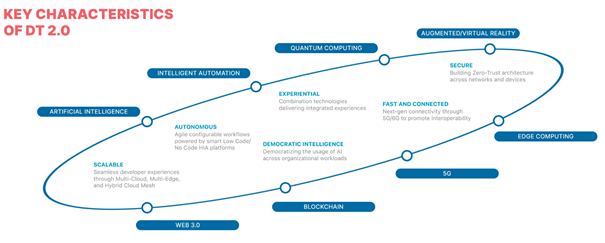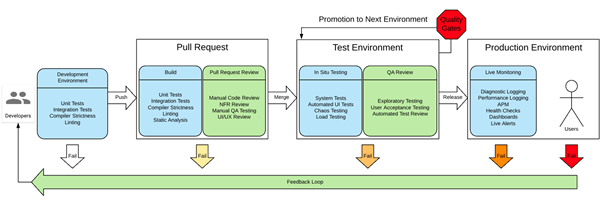The evolution of technology is happening at a breakneck speed, primarily led by new-age technologies like AI, ML, among others. Businesses that were earlier alienated from technology are now being forced to reinvent the wheel to stay relevant in the market. Automating critical business processes is integral to reap improved ROI and provide a much better experience to customers & employees alike.
Digital transformation has taken center-stage for businesses, irrespective of its size and/or scale. In fact, digital transformation can be considered industry and business agnostic since every business has at least some flavor of technology integrated in it!
Cloud computing, Metaverse, OpenAI, Quantum computing, Cloud-native applications, etc. are some of the technologies that will unlock immense growth opportunities for businesses (or enterprises). As per reports, these emerging & fast-growing technologies are estimated to have a market-size of $1.6 trillion by 2030[1].
Characteristics of Digital Transformation (DT) 2.0
At the core of it, Digital Transformation (Dx) is all about improving the existing technology and automating the laggard business processes in order to save costs, improve productivity, and unlock newer avenues to expand the business. In this blog, we look at how software automation testing can be integrated in the larger picture of digital transformation for attaining faster feedback loops and accelerating quality software releases.
The learnings of this blog can be your go-to guide for taking the crucial steps in the digital transformation journey…
Note: Organizations, businesses, and enterprises are used interchangeably throughout the course of the blog.
What is Digital Transformation?
Before we solve the puzzle ‘Why automation testing in digital transformation’, let’s do a quick recap of the essentials of digital transformation. With the rapid proliferation of digital technologies (e.g. AI, ML, cloud computing, etc.) it is important for enterprises (or businesses) to leverage their potential for accelerating the growth of the business.
Here are some of the major technologies & practices (in no particular order) that can be a part of an organization’s digital transformation roadmap:
| 1️⃣ Artificial Intelligence | 2️⃣ Machine Learning |
| 3️⃣ Big Data | 4️⃣ Automation Testing |
| 5️⃣ Continuous Integration (CI) | 6️⃣ Continuous Deployment (CD) |
| 7️⃣ Augmented Reality (AR) | 8️⃣ Virtual Reality (VR) |
| 9️⃣ Metaverse | 🔟 Digital Twin |
| 1️⃣1️⃣Internet Of Things (IOT) | 1️⃣ 2️⃣ Industrial Internet Of Things (IIoT) |
Digital transformation is primarily used for improving the business processes and unlocking business opportunities, thereby driving more value to all the key business stakeholders (e.g. customers, employees, etc.). Technology laggards[2] should consider digital transformation at a very high priority, since it will yield immense results in short-term and long-term.
For laggards, digital transformation will prove vital in improving the operational efficiency at every level in the business. In a nutshell, digital transformation is more about utilizing the latest technologies to drive business growth and creating a monumental shift in the organization’s culture and mindset.
In the further sections of the blog, our primary focus will be on capitalizing on automation testing for maximizing the ROI on digital transformation. Test automation services companies could be potential change-makers in realizing the potential of digital transformation.
Test Automation: Key Accelerator In Digital Transformation
By now it is very much evident that enterprises need to shift technology orbits to stay ahead of the curve! Having said that, let’s jot down some of the key avenues where test automation (or automated testing) can accelerate the outcomes associated with digital transformation:
Acceleration in software releases
Transforming a business by prioritizing technology in key business functions requires a culture change and shift in stakeholder’s mindset. Implementation of incremental changes must be considered since it becomes easy to adapt to those changes!
On similar lines, incorporating test automation in the big scheme of things starts with identifying the potential road-blockers that delay software releases. Repeated tasks that do not require manual intervention (or human intelligence) are key contenders for test automation.
Non-regression automated tests are instrumental in reducing the developer feedback loops – a factor that eventually helps in accelerating quality software release. The critical process of (Bug Identification → Bug Reporting → Bug Assignment → Bug Fixes → Testing) takes less time when business & testing practices are transformed using technology.
Significant Cost Reduction
It is a known fact that there is cost associated with software bugs and cost depends on the stage at which the bug was located in the product. Bugs discovered at later stages[3] have higher costs associated with them. By inculcating the best practices of test automation, teams can minimize the gravity associated with defects as each feature (or bug fix) undergoes multiple rounds of testing.
Shift left testing combined with DevOps (or CI/CD) tools helps in validating changes at every stage, thereby helping teams deliver quality software with higher velocity. Earlier identification of bugs catalyzed by CI/CD pipelines & shift left testing results in accelerating validation cycles and minimizing the costs associated with bugs (at every stage of product development & testing).
An experienced QA automation testing services company can play a key role in achieving higher ROI from automated testing – a key pillar in the digital transformation journey.
Also Read: Regression Testing in CI/CD
Enablement of Continuous Integration and Delivery
Changes in customer requirements, underlying business logic, and/or infrastructure are common in the software field. Such changes could disrupt the business (or project) continuity in case the continuous monitoring & continuous feedback mechanism is not in place.
Business transformation catalyzed by digitalization helps in avoiding mishaps associated with any changes across the board (i.e. stack). Test automation being a key enabler in the Continuous Integration (CI) and Continuous Deployment (CD) pipelines helps in nullifying the risks that come along with business/software level changes.
CI/CD Model
As shown below, automated feedback loops in CI/CD improves visibility, thereby letting software teams handle business changes with limited disruption. The culmination of shift-left testing, test automation, and CI/CD is influential in realizing continuous product improvement that reap significant benefits in the short-term and long-term.
Automation Testing: Guiding Pillar of Digital Transformation
From what we have seen so far, it is evident that digital transformation is a continually evolving process. Results from the digital transformation process must be monitored so that relevant changes can be brought-in if things are not falling in place.
On the whole, digital transformation has the potential to reshape (or rediscover) customer experience[4] that can further increase the revenue by 20% to 50%. All of this can only be achieved by capitalizing on the benefits offered by automated testing.
Automation testing is one of the key catalysts in digital transformation. It helps enterprises reduce costs, improve software quality, enhance developer velocity, and ship quality products at a faster pace. Lastly, incorporating shift-left principles in digital transformation lets teams build a quality-first culture, thereby maximizing the ROI of test automation and digital transformation.









